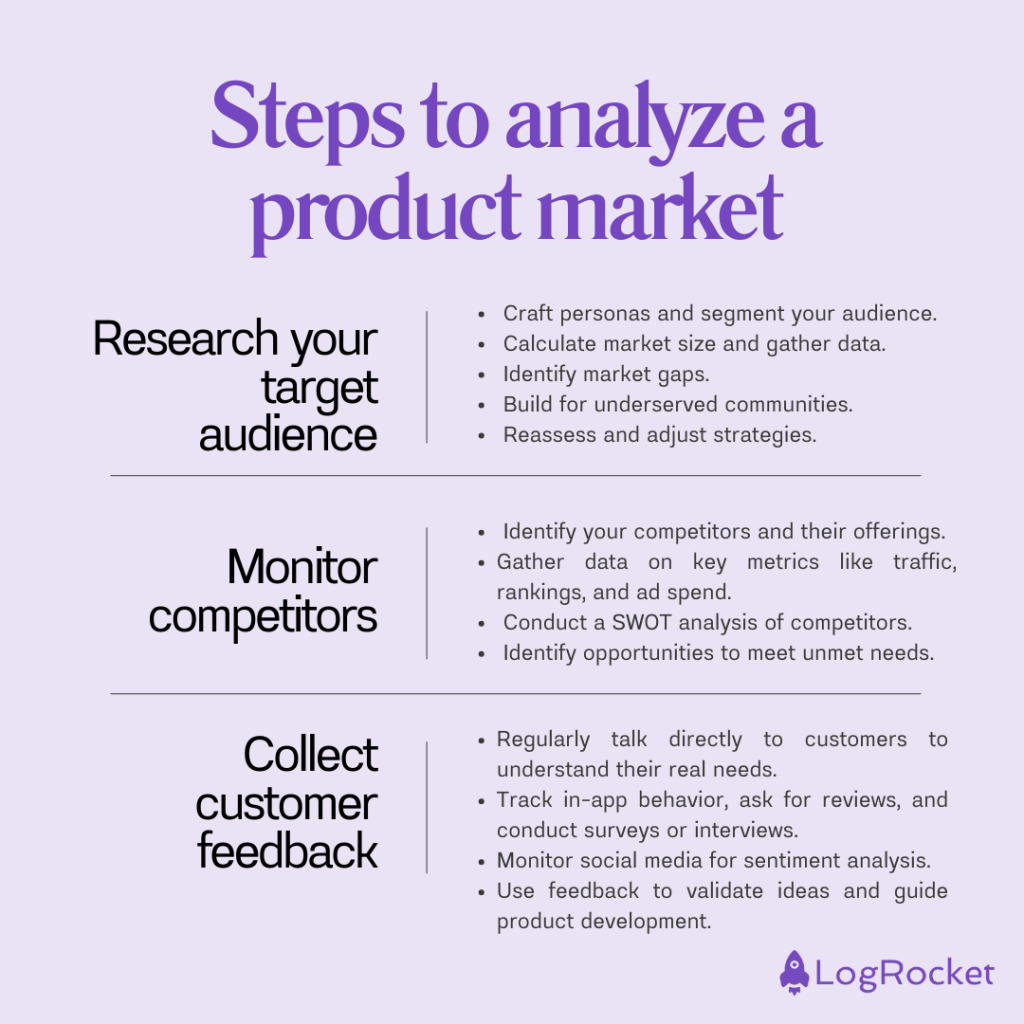
The core of product management is your target market. As a product manager, you hold the key to bridging the gap between an audience’s needs and your company’s product. Achieving product-market fit is non-negotiable in a competitive landscape.
In this article, I explore the concept of product markets, its significance in product management, and strategies to align products with target markets.
What is a product market?
In product management, the product market refers to the specific target customers a product is designed to serve. A product should aim toward serving the underserved needs of the target audience.
Creating a product that serves the needs of everyone is a mistake. Attempting this can make it difficult to develop a product that has a useful purpose. Marketing will also have a hard time deploying a strategy that resonates with an audience.
Instead, as a product manager, you need to have a thorough understanding of the market, trends, and target audience. Once you know an audience’s demographics and psychographics, you can find their underserved needs. That’s the sweet spot to bridge the gap between a customer’s need and a valuable product.
How to analyze a product market
Product market analysis is a crucial part of making informed business decisions. Before beginning product development, you need to know the product market.
When I begin looking at the product market, I want to find the answers to two questions: Who is the target audience, and what are their underserved needs? Without these answers, it’s impossible to find a product-market fit.
For example, you may discover that your market has a lot of competition. If so, it’s critical to figure out the unmet needs of your target audience. You need to find pain points that are not being addressed and create a product that solves those problems. Otherwise, you may not be able to break into the market.
Conducting a product market analysis helps you identify market gaps or places where customer needs are unmet. You can determine this by understanding your target audience and researching your competitors. Here are a few components of market analysis:
1. Research your target audience
The first step is to know your market and which personas would most likely benefit from your product. You can’t build, let alone market, a product that doesn’t have a specific audience. Crafting a user persona is crucial to determining an audience’s behavior, needs, pain points, and goals.
Here are a few other things I like to think of when I conduct market research:
- Size of the potential target market by calculating your market penetration rate
- Gathering first-party data via surveys, interviews, and customer feedback. It helps gather direct insights about the target audience
- Identifying gaps in the market that need a unique product as a solution. Mapping the customer journey or doing a competitor analysis helps find gaps
- Segment the audience for better targeting and engagement. Smaller groups can make it easier to determine demographics, purchase intent, and interests
Ultimately, researching your target audience can help you find underserved communities or other gaps in service. Once you understand your market, you can move forward with building a product that reaches product-market fit.
2. Monitor competitors
Too often, a lot of emphasis is put on understanding the audience, but you mustn’t forget about your competitors. They are already serving your audience. If you want to stand out, compare your product to several competitors. Competitor analysis is crucial to identifying gaps in the market that you can leverage toward building a strong product. You’ll want to take a deep dive into their product offerings, customers, pricing, and marketing strategies.
There are several frameworks for conducting a competitor analysis. In the end, an analysis of your competitors will generally include the following steps:
- Define competitors, who may be companies offering the same product or a different product that offers the same solution
- Gather data on key metrics, including data such as website traffic, search rankings, ad spend, and other relevant insights
- Conduct a SWOT analysis to assess the strong and weak points of a competitor
- Identify opportunities where an unmet need can be served with a new product
3. Collect customer feedback
Collecting customer feedback is the foundation of creating a strong product. “My number one rule is to not go too long without talking to customers. When I say talking to customers, I mean actually talking to the people who will use your products,” explains Umesh Unnikrishnan, VP of Product at Branch.
“At a big company, there’ll be people in between you and the customer — salespeople, marketers, user research people, all of whom are proxying the customer to you. But unless you talk to a real customer, you don’t really know the problem they’re facing.”
Unnikrishnan gave the example of a customer request for an iPhone app. Upon meeting with the customer, they realized that the customer didn’t need an app — they needed a scheduling feature.
Creating this feature was much easier and more cost-effective than developing a whole app. Unnikrishnan and the product team would never have discovered this if they hadn’t talked to a real customer about their problems.
Collecting feedback directly from customers is essential to discovering their needs. A few ways to gather customer feedback include:
- Track in-app customer behavior
- Ask for product reviews
- Conduct surveys or interviews
- Gather user feedback on your app
- Monitor social media for sentiment analysis of your industry
Always stay in touch with your customers and target audience. They are valuable for validating your product idea, guiding development, and setting the foundation for sustainable business growth.

Importance of product-market fit
Product-market fit describes a scenario where a product fulfills the needs of a specific market segment. Some of the main benefits of achieving product-market fit include:
- Confirms market demand — You need to verify that your product idea is an actual need for your specific target audience. Product-market fit can confirm this demand within your market
- Guides product development — Companies are better equipped to efficiently allocate resources with a product-market fit. It guides decisions on product development and the overall business model. Product-market fit also helps reduce the risk of developing products that don’t appeal to your target market
- Creates a foundation for growth and success — Achieving product-market fit may lead to generating higher revenue and profits and standing out from the competition. It can make it easier to attract investments and fundraising opportunities
- Increases customer retention — Competitors won’t have your edge, so satisfied customers are more likely to continue using your product. They may also develop into loyal advocates of your brand
Without product-market fit, companies will struggle to gain traction and won’t receive any returns.
For example, ProfitWell (now part of Paddle), a business intelligence solutions provider, wanted to align new integrations with consumer demand. Specifically, the company needed to know its customers deeply and how they used its software. Third-party tools, such as LogRocket, helped track user behavior, which ProfitWell implemented. The data led to insights on user trends, which helped inform decisions about new integrations.
Strategies for achieving product-market fit
Product-market fit is crucial for your business. Implement these strategies to discover the needs of your target market and what products will succeed:
- Know your customers — Conduct market research to identify the needs and desires of your target market. You may also want to consider researching similar audiences to see if you can align with their needs
- Develop an MVP — A minimal viable product (MVP) allows for quicker market entry and is a good starting point for collecting user feedback. It helps minimize the risk of putting out a fully-developed product that isn’t met with great enthusiasm
- Pivot based on feedback — Make sure you have a strong customer feedback loop to stay in touch with your target market. You may find opportunities to quickly adjust to their needs, which can increase satisfaction
- Test assumptions — It’s easy to assume you know your audience well enough, but it never hurts to confirm your assumptions. Always test your ideas to ensure you are building a customer-focused product
- Use data analytics — Leverage data to inform your product decisions. Data analytics are excellent tools to glean insights into your audience and their behavior
Beyond traditional processes, consider how AI can help identify promising markets with high potential.
Since AI can evaluate the market in real time, it can provide insights allowing marketers to quickly adapt their strategies. These strategies may include altering product messaging, targeting different yet receptive audience segments, and predicting new trends.
By leveraging AI in product strategies for market research and segmentation, managers are better positioned to reach product-market fit. AI integration can help products stay responsive to market changes and ensure audiences have their needs met.
Key takeaways
Product markets are always on a journey. Companies need to stay on top of trends to stay competitive. Leveraging trends to inform product decisions will create sustainable growth.
Stay informed by always involving customers in the development process. It will make it easier to know when to pivot to stay aligned with customer demand.